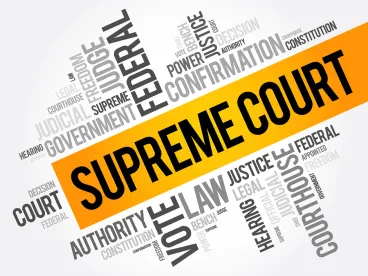Yes, you read that correctly. On June 21, 2018, the United States Supreme Court handed down its decision in South Dakota v. Wayfair, Inc. [1] (We’ve discussed the background to Wayfair here, here, here, and here.) The Court, by a 5 – 4 majority, held that a vendor need not have a physical presence in a state in order to have a “substantial nexus” with the state under the Commerce Clause that could obligate the vendor to collect sales or use taxes on sales made to customers who reside in the state and to remit those taxes to the state. Consequently, the Court overruled its prior holdings in National Bellas Hess, Inc. v. Department of Revenue of Illinois, 386 U.S. 753 (1967), and Quill Corp. v. North Dakota, 504 U.S. 298 (1992), that a vendor must have a physical presence in a state to be required to collect sales/use taxes on sales made to residents of that state.
To learn what three things you should know about Wayfair and its effect on remote (read: Internet-based) vendors, read on after the jump.
What did the Court do?
The Court did not hold that the South Dakota law that imposes a sales/use tax collection and remission obligation on certain remote vendors satisfies each prong of the Commerce Clause analysis that applies to a state tax on interstate activity. The Court held that the physical presence requirement adopted by Bellas Hess and Quill for purposes of determining whether a remote vendor has substantial nexus with a state for purposes of sales/use tax collection and remission is no more. The Court also held that the South Dakota law does not violate the substantial nexus prong of the Commerce Clause analysis, because this law applies only to vendors who (i) have annual sales of more than $100,000 of taxable goods and/or services into South Dakota or (ii) engage on an annual basis in at least 200 transactions for the delivery of taxable goods and/or services into the State.
Physical presence (or, more precisely, the lack thereof) was the only Constitutional impediment to the South Dakota law that the parties litigated. Accordingly, the Court remanded the case to the South Dakota Supreme Court for further proceedings not inconsistent with U.S. Supreme Court’s opinion. The Court did observe, however, that the South Dakota law contained three features that were designed to ensure that the sales/use tax collection and remission obligation imposed on certain remote vendors does not discriminate against interstate commerce in favor of intrastate commerce and is not unduly burdensome on interstate commerce. These three features are: (1) the South Dakota law does not obligate a remote vendor to collect and remit South Dakota sales/use taxes if the vendor does not have at least $100,000 of annual taxable sales in South Dakota or at least 200 annual transactions for taxable sales in the State; (2) the obligation to collect and remit South Dakota sales/use taxes cannot apply retroactively; and (3) South Dakota has joined the Streamlined Sales and Use Tax Agreement.
What now?
The U.S. Supreme Court appeared to be signaling to the South Dakota Supreme Court its view that the South Dakota sales/use tax collection and remission law passes Constitutional muster. Perhaps more importantly, the U.S. Supreme Court appeared to be signaling to all states that levy a sales tax that they should enact laws that accord with the favorable characteristics of the South Dakota law (and join the Streamlined Sales and Use Tax Agreement) if they wish to succeed in requiring remote vendors to collect and remit sales/use taxes. Don’t be surprised to see states both (i) forego retroactive enforcement of sales/use tax collection and remission obligations and (ii) join the Streamlined Sales and Use Tax Agreement to ensure that they can compel remote vendors to collect and remit sales/use taxes.
What about Congress?
Congress does, of course, have plenary power under the Commerce Clause to regulate interstate commerce. Thus, Congress could enact a law that reverses Wayfair and reinstates the physical presence standard. The creation of such a tax shelter is within the province of Congress, not the judiciary. As the opinion of the Supreme Court in Wayfair makes clear, Commerce Clause jurisprudence should treat interstate and intrastate commerce evenly and should not favor one over the other. The Court acknowledged in Wayfair that its decisions in Bellas Hess and Quill resulted in a judicially crafted tax shelter that favored interstate commerce to the detriment of intrastate commerce.
This was not a bloodless exercise. Bellas Hess and Quill have deprived state and local governments of billions of dollars of sales/use tax revenue. They have also contributed to the demise of small brick-and-mortar retailers and the proliferation of empty storefronts and dead (or dying) shopping malls. The resulting unemployment and blight have further strained the resources of state and local governments, which were bereft of the sales/use tax revenue that should have been collected and remitted by the remote vendors who, with the help of the Supreme Court, drove under a not insignificant portion of their brick-and-mortar competitors.
Perhaps internet-based remote vendors would have triumphed over their brick-and-mortar competitors in any event, but they did not need the scales of justice slanted in their favor. The creation of tax shelters is a uniquely legislative function. Unlike the judiciary, members of Congress are answerable to their constituents. If they feel it’s good policy to reverse Wayfair and adopt a tax shelter for interstate commerce, they can do so and see if they face an electoral rebuke. Judges should be neutral in these matters – a lesson it took the Supreme Court 51 years to learn.
[1] Wayfair has several interesting undercurrents. South Dakota prevailed where North Dakota failed. Justice Kennedy, the Court’s long-time swing voter, wrote what turned out to be his last opinion of the Court. The 5 – 4 split among the justices did not hew to ideological lines. Justice Kennedy’s opinion was joined by liberal Justice Ginsburg and conservative Justices Alito, Gorsuch, and Thomas. Chief Justice Roberts, a member of the Court’s conservative bloc, wrote the dissenting opinion, which was joined by liberal Justices Breyer, Kagan, and Sotomayor. The dissenting opinion agreed with the opinion of the Court that Bellas Hess and Quill were wrongly decided, and there was no disagreement that a resident of a state that imposes a sales or use tax owes sales or use tax when the resident purchases goods from a remote vendor. With such broad agreement, why the sharp, albeit unconventional, split amongst the justices? For some justices, slavish devotion to stare decisis knows no bounds (even if it means calling an obvious strike a ball, something no self-respecting umpire would ever countenance).




 />i
/>i

